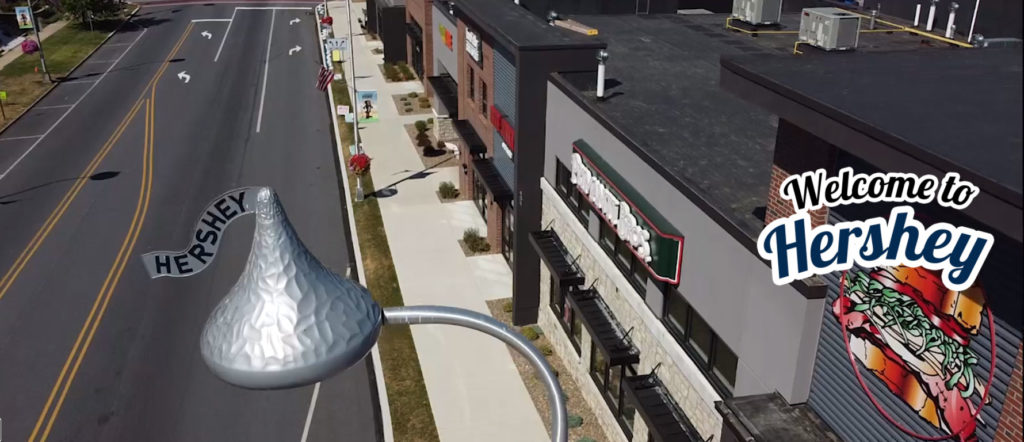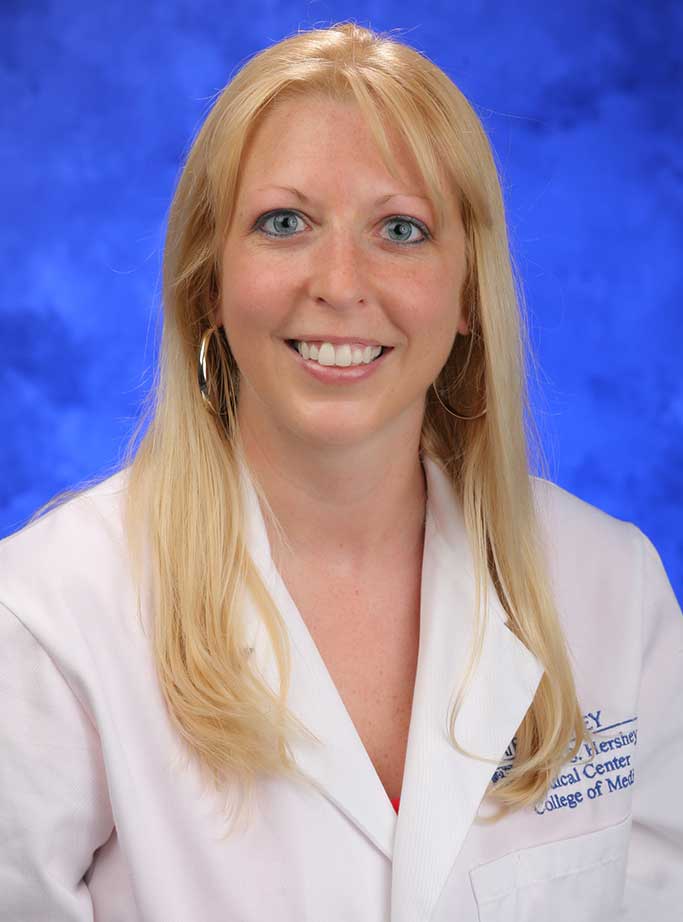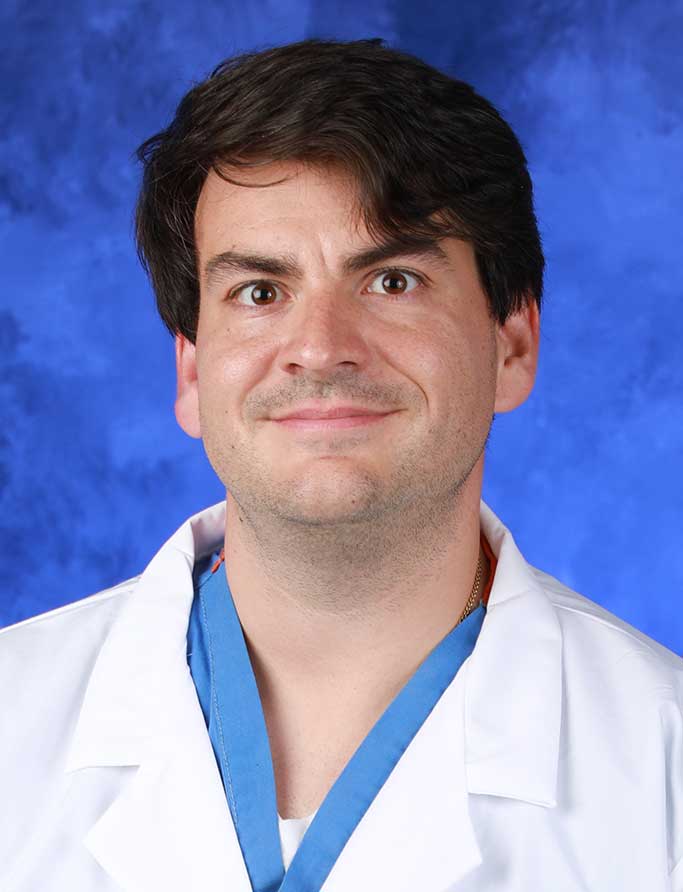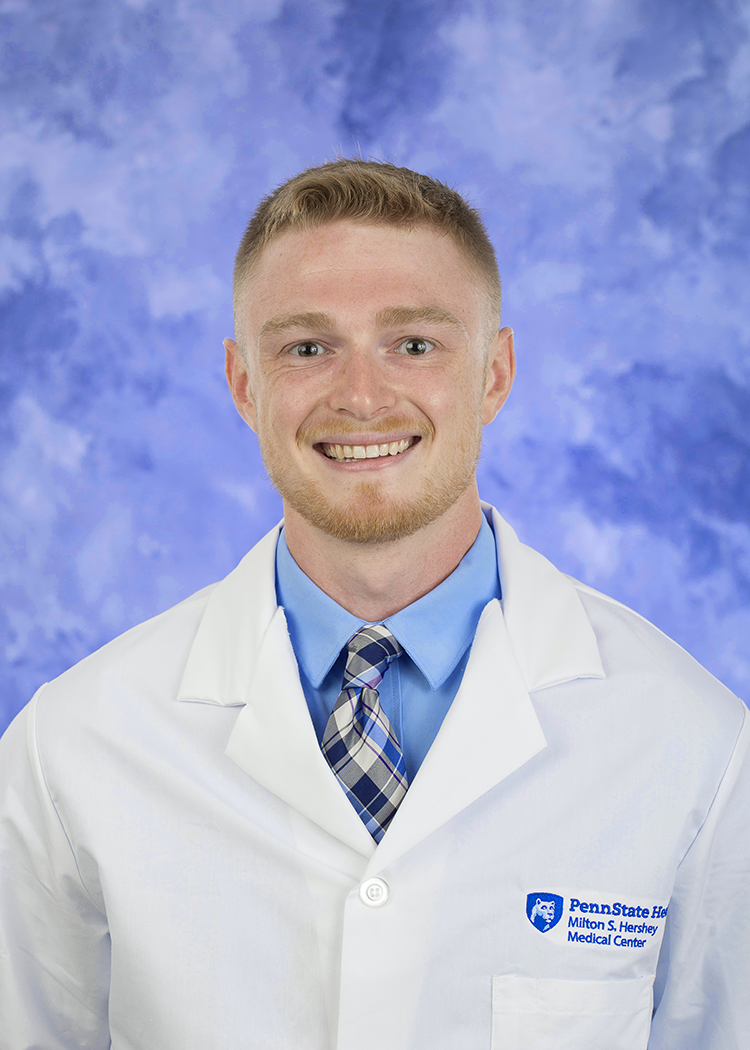Jump to topic
Search
Program Details
The Anesthesiology and Perioperative Medicine residency is structured to prepare physicians for careers as consultants in anesthesiology, in either academic medicine or private practice.
Residents in the program learn far more than safe techniques for anesthetic administration. They acquire the judgment and skills needed to care for complex patients and interact with physicians and other health care providers to ensure excellent care of patients in and outside the operating room environment, with expanded exposure and experience in perioperative medicine.
“To this day, I recommend Hershey strongly and without reservation to medical students looking for an Anesthesiology residency. The clinical skills, basic science, and most of all teaching that I received from PSHMC are with me to this day, and I still see large swaths of my practice that are directly attributable to my attendings there.”
The program is very enthusiastic about its innovative integrated four-year curriculum, which is one of the few four-year programs in the country that integrates the clinical base rotations throughout the first three years of residency training. This approach is now becoming increasingly popular among other programs, and Penn State Health was one of the first to implement this continuum more than 10 years ago.
ACGME requirements are followed for all rotations. The program has selected rotations that will contribute to the experience and body of knowledge necessary to maximize the residents’ education in becoming superior consultants of anesthesiology. Rotations increase in complexity as the resident increases in experience in both the clinical base and the clinical anesthesiology rotations. This allows the resident both to contribute more to each patient’s care and to gain more depth of knowledge from their experience on every rotation.
Learn More about the Residency
The Department of Anesthesiology and Perioperative Medicine celebrates several events throughout the year. These events can be an opportunity to dress up and break up the monotony of everyday life. There are two formal events and one picnic per year and a number of informal events where significant others are also invited.
Welcome Picnic
The first event of the academic year is celebrated in August. The department congregates at Mount Gretna Lake for a catered picnic, socializing and friendly sportsmanship. Department members and their families are welcome to play volleyball and race canoes across the lake. These activities allow everyone to get to know each other on a personal level. This event allows the department to welcome incoming faculty, CRNAs, fellows, residents and new staff members to the department.
The Priestley Event
The Priestley Event is held every year on the first Friday of December at Hershey Country Club. In recognition of the great scientist Joseph Priestley, a former chair of anesthesiology inaugurated the annual Joseph Priestley Lecture Series in the department in 1995. The speakers in this well-established lecture series includes preeminent anesthesiologists from around the world who deliver two lectures over two days.
Resident and Fellow Graduation
Every year, the department gathers to celebrate the accomplishments of its residents and fellows as they complete their training. This event is held in late June at The Hotel Hershey. All department members and significant others are invited to attend, as well as the families of the graduates.
The event features a formal cocktail hour and dinner, as well as a commencement speech given by a previous graduate. Each graduate is then honored for their accomplishments with a certificate of completion and a coveted Penn State Nittany Lion.
The evening dinner is a great time reflect on the past four or more years of education and development and reward the graduates for their hard work and accomplishments.
Resident Social Time
A resident social committee plans group outings, cookouts and celebrations that occasionally include residents from other specialties. Several of these events are held during the end of June/beginning of July to give incoming residents the opportunity to meet as many of their colleagues as possible prior to their start in the program.
Some of the social venues over the years have included Troegs Brewing Company in Hershey, Spring Gate Winery in Harrisburg, baseball at Clipper Magazine Stadium and concerts at HersheyPark Stadium.
General Application Information
Penn State College of Medicine participates with ERAS and the NRMP Match. All application material must be submitted through ERAS.
Applicants with suitable qualifications will be invited to interview through Thalamus.
The program recruits 18 PGY-1 (categorical) positions each year through the NRMP Match process. Any potential increase or decrease to the complement will be communicated to applicants. Due to NRMP Match policy, the program cannot offer out-of-the-Match positions for PGY-1 or PGY-2 candidates. Refer to the program information listed in FREIDA for details.
Application deadline is Dec. 31. Applicants are invited to check the status of their application by emailing the Program Coordinators at Anes_ResidencyProgram@pennstatehealth.psu.edu. All correspondence regarding applications should be conducted through this inbox to avoid delays.
Application Details
All applications will be reviewed in their entirety, and an invitation to interview is based on the entire application and not simply exam scores. However, the program has the following preferences and requirements:
- U.S. clinical experience is not required; however, anesthesia electives and/or anesthesia experience are preferred
- USMLE Step 1 & 2 or COMLEX Levels 1 & 2 are required to be selected for an interview. USMLE Step 2 should be no less than 225 and COMLEX Level 2 of 550 or higher for osteopathic graduates. USMLE is not required for those who have taken COMLEX. There is no official limit for the number of attempts for either exam; however, the number of times the exam has been taken may impact the strength of the application.
- Applications must include three letters of recommendation, a dean’s letter, medical school transcripts, curriculum vitae and personal statement.
- ECFMG certification must be supplied before beginning as a resident.
- The institution accepts residents on J-1 visas only. The visa application process and applicable fees are the applicant’s responsibility.
- The recruitment team prefers to see graduation from medical school within five years of submitting the ERAS application. However, this is dependent upon what clinical/research experience the applicant has had since graduating from medical school.
Couples-Matching
If someone who is invited to interview is couples-matching with an applicant interviewing with another department at Penn State Health Milton S. Hershey Medical Center, the Department of Anesthesiology and Perioperative Medicine will be happy to help coordinate with the other department as much as possible. Applicants in this situation should contact the program office about their partner’s interview, as the program may not have the information.
If both partners apply to the Anesthesiology Residency, in cases where both are invited to interview, the program will make every attempt to schedule both interviews for the same session. Each applicant will be ranked appropriately based on individual qualifications and not solely on a couples match.
Interview Process
All interviews and social gatherings will be conducted virtually. ERAS will be used for application submission. Scheduling and interviews will be through the Thalamus platform.
A Commitment to Teaching
Over the years, the Department of Anesthesiology and Perioperative Medicine has attracted and cultivated an outstanding faculty team, most with subspecialty interests that serve as a focus for their teaching and research endeavors. A number hold the PhD degree, which is evidence of their commitment to advancing the scientific basis of anesthesia.
“Residency can be tough for anybody going through those four years… I feel that at Penn State Health, residents can really reap a great deal of clinical experience. You don’t have to look very far to learn from a case or an attending mentor… I learned a ton.”
In addition, the backgrounds of the faculty reflect a refreshing diversity. A fine balance exists between those trained within the department and those trained at other leading institutions around the world. The former provide stability to the educational program, while the latter bring perspective and innovation.
The department has achieved a nationwide reputation for academic excellence. Achievements by individual faculty add to its prominence.
The present faculty roster includes faculty members who are:
- Subspecialty-certified in critical care medicine
- Subspecialty-certified in pain management
- Fellowship-trained in pediatric anesthesia
- Trained in neuro-anesthesia
- Trained in cardiac, thoracic and vascular anesthesia
- Research scientists
Several members of the faculty have been elected for membership in the prestigious Association of University Anesthesiologists. Strong basic and clinical research activities lie at the center of the Department of Anesthesiology and Perioperative Medicine. Faculty members hold positions on various national committees and boards of national societies and serves as directors of organizations.
Meet the Faculty
Stay in Touch
Program graduates are asked to:
- Update information to remain on the program’s mailing list
- Complete the Residency Alumni Survey
- Email the program a testimonial
Testimonials from Penn State Health Anesthesiology Residency Alumni
“When I chose a residency program in medical school, I wanted one that would prepare me to take care of any patient, in any clinical situation. HMC taught me that and much more.”
“This is a great program. It’s a great honor to be a Penn State Health Alumni.”
“PSU really prepared us for Private Practice. From pediatrics to regional to cardiac/thoracic to OB, etc… The first days are always a little scary, but that goes away quickly as one realizes that the training shines through in what you do. Coming out of residency we both feel confident.”
“I am extremely impressed at the quality of my education, having now moved on to a directorship at a children’s hospital. With what I learned in Hershey, I can walk into any OR, and feel safe that I have the skills, expertise and a healthy sense of doubt (thus attention to safety detail) to manage patients and emergencies. Part of this is the mentoring I received at Hershey, part of this is the solid basis of knowledge that was a priority for our anesthesia medical education program. I have now had the opportunity to observe others, and realize that Hershey is an echelon above the rest when it comes to GME in anesthesiology… kudos!”
Past Resident Listing
Virtual Tour
Penn State Health
Penn State Health is a multi-hospital health system serving patients and communities across 29 counties of Pennsylvania. Its mission is to improve health through patient care, research, education and community outreach.
In December 2017, the system partnered with Highmark Health to facilitate creation of a value-based, community care network in the region. The shared goal of Highmark and Penn State Health is to ensure patients in the community are within:
- 10 minutes of a Penn State Health primary care provider
- 20 minutes of Penn State Health specialty care
- 30 minutes of a Penn State Health acute care facility
Learn more about Penn State Health
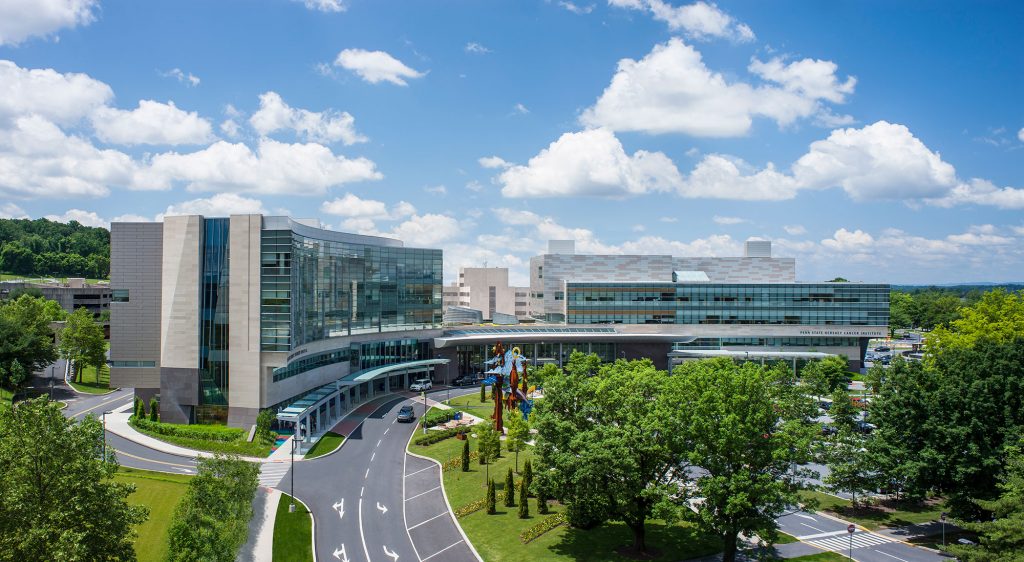
Penn State Health Children’s Hospital (left), Penn State Health Milton S. Hershey Medical Center (center) and Penn State Cancer Institute (right)
Penn State Health Milton S. Hershey Medical Center
500 University Dr., Hershey, Pa., 17033 (Derry Township, Dauphin County)
- The health system’s 647-bed flagship teaching and research hospital
- The only medical facility in Pennsylvania accredited as both an adult and a pediatric Level I (highest-level) trauma center
- Dedicated surgical, neuroscience, cardiovascular, trauma and medical intensive care units
- Accredited Life Lion critical-care transport providing more than 1,100 helicopter and approximately 750 ground ambulance transports per year
- More than 1,300 faculty members and more than 650 residents and fellows
- Approximately 29,000 admissions, 73,000 emergency department visits, 1.1 million outpatient visits and 33,000 surgical procedures annually
- Designated as a Magnet hospital since 2007
Learn more about Milton S. Hershey Medical Center
Penn State Health Children’s Hospital
600 University Dr., Hershey, Pa. 17033 (Derry Township, Dauphin County)
- An eight-story, 263,000-square-foot-facility built in 2013 and expanded in 2020
- 146 licensed pediatric beds, 18 acute care beds and a 56-bed neonatal intensive care unit
- Level IV (highest-level) neonatal intensive care unit
- Level I quaternary (highest-level) pediatric intensive care unit
- Level I (highest-level) pediatric trauma center designation
- Intermediate care unit
- Dedicated pediatric operating rooms
- More than 150,000 pediatric outpatient visits and approximately 5,000 pediatric patient discharges annually
Welcome to Hershey
More About Hershey
Interested in learning more about living and working in Hershey, Pa.? See details here:
Wellness, including emotional, spiritual, social and physical health, is a crucial component to training and to becoming a professional, compassionate and resilient physician. Self-care is a skill which must be continually practiced and reinforced. Penn State College of Medicine and Penn State Health are committed to addressing wellness among residents and fellows, with multiple resources readily available.
Institutional resources
- Visit BeWell – a health program designed to support Penn State Health employees
- See Penn State College of Medicine wellness resources here
- Employee Health Care Concierge and Case Management Service
- Partners in Medicine
Moving to a new city with your family does not have to be stressful. Residency programs have assisted many significant others with finding employment. There is also a GME-Wide Partners in Medicine (PIM) group that offers networking opportunities as well as various social and community oriented activities. - The Doctors Kienle Center for Humanistic Medicine
- Active and easily accessed Office of Professional Mental Health
Graduate medical education resources
Program Resources
Wellness is not just a buzzword but a call to action in the Anesthesiology Residency, which has many initiatives throughout the year. A few highlights include:
Dedicated education time
Weekly education sessions are scheduled from 2 to 4:45 p.m. Residents are then relieved for the day following these sessions. This is another block of guaranteed time that offers residents the ability to make plans with friends and family freely without the fear of cancelling last minute due to being stuck in an OR.
A thriving social committee
This group offers weekly inter-departmental gatherings, huge perioperative parties quarterly with surgical residency trainees and many other events. The group organizes many events and communicates frequently throughout the year.
Department appreciation
The Department of Anesthesiology and Perioperative Medicine recognizes the value of appreciating its residents, and finds opportunities throughout the year for fun activities. These offer a chance to vent, bond and enjoy each other’s company outside the ORs. Faculty also open their homes for gatherings – Basic Exam celebration, potluck parties, pool parties, luaus, Halloween costume festivities and Super Bowl bashes, to name a few.
Institutional Resources
Penn State Health and Penn State College of Medicine celebrate, embrace and support the diversity of all patients, faculty, staff, students and trainees.
Office for Diversity, Equity and Inclusion
In keeping with this, Penn State Health has an active Office for Diversity, Equity and Inclusion with various programs, networks and resource groups, including:
- Talks and lectures on diversity, equity and inclusion through the Inclusion Academy
- Regular events on topics such as eradicating racism and creating a culture of inclusiveness
- Many Business Employee Resource Groups (BERGs), including:
- Disability Business Employee Resource Group
- Interfaith Business Employee Resource Group
- LGBTQ+ Business Employee Resource Group
- Military and Veterans Business Employee Resource Group
- Multicultural Business Employee Resource Group
- NextGen Business Employee Resource Group
Learn more about the Penn State Health Office for Diversity, Equity and Inclusion
Learn more about the College of Medicine’s Office for Diversity, Equity and Belonging
Office for Culturally Responsive Health Care Education
The vision at Penn State College of Medicine and Penn State Health is to equip learners with the knowledge, skills and attitudes they will need to provide culturally excellent health care and research for an increasingly diverse U.S. population. The Office for Culturally Responsive Health Care Education was formed to help meet that goal.
Learn more about the Office for Culturally Responsive Health Care Education
Office for a Respectful Learning Environment
In addition, the institution does not tolerate discrimination, biases, microaggression, harassment or learner mistreatment of any kind, and any concerns are immediately addressed by the Office for a Respectful Learning Environment.
Learn more about the Office for a Respectful Learning Environment
Network of Under-represented Residents and Fellows
The Network of Under-represented Residents and Fellows (NURF) is a group of diverse residents and fellows representing all specialties. NURF’s goal is to promote cultural diversity in the residency programs through community involvement, mentorship with diverse faculty, professional networking and support for the recruitment of diverse medical students into the residency programs.
NURF is sponsored by the Penn State College of Medicine Graduate Medical Education Office and the Penn State Health Office for Diversity, Equity and Inclusion.
Mailing Address
Penn State Health Milton S. Hershey Medical Center
500 University Dr., H187
Hershey, PA 17033
General Contact Info
Phone: 800-206-7718
Fax: 717-531-0826
Curriculum Details
Curriculum: Clinical Base/PGY-1
- CB: Emergency department
- CB: Internal medicine consults
- CB: Medical intensive care unit (MICU)
- CB: Surgical anesthesia intensive care unit (SAICU)
- CB: Trauma surgery
- CB: Pain medicine
- CB: Quality improvement (QI)
- CB: One-on-one anesthesia
- Acute pain management service
- Orthopaedic anesthesia
- Outpatient anesthesia
- General anesthesia (two blocks)
“In the end, it’s a great place to train. Just thought I’d give you my perspective. For what it’s worth, I love my job and I truly feel blessed to be part of such an exceptional profession. I owe Penn State a big ‘thank you.’ Not all residencies are created equal.”
Curriculum: Clinical Anesthesia I/PGY-2
- CB: Cardiology consult service
- CB: Pulmonary
- CB: Ear, nose and throat (ENT)
- CB: Pediatric pulmonary/cardiac critical care unit
- CB: Elective
- Pediatric anesthesia I
- Obstetrical anesthesia I
- Neurosurgical anesthesia I
- Cardiothoracic anesthesia I
- ENT anesthesia
- Post-anesthesia care unit (PACU)
- Neurosurgery intensive care unit (NSICU)
- Surgical anesthesia care unit I (SAICU)
Curriculum: Clinical Anesthesia II/PGY-3
- Perioperative medicine
- Pediatric anesthesia II
- Obstetrical anesthesia II
- Neurosurgical anesthesia II
- Cardiothoracic anesthesia II
- Vascular/transplant anesthesia
- Pain medicine II
- Preoperative anesthesia clinic
- Advanced clinical anesthesia (four blocks)
- Surgical anesthesia care unit II (SAICU)
Curriculum: Clinical Anesthesia III/PGY-4
- Advanced and complex anesthesia (two blocks)
- Hershey Outpatient Surgery Center (HOSC)
- Regional anesthesia
- Endo/alternate site anesthesia
- Surgical anesthesia care unit III (SAICU)
- Electives (seven blocks)
Electives include:
- Advanced and complex anesthesia
- Hershey Outpatient Surgery Center (HOSC)
- Pediatric anesthesia III
- Obstetrical anesthesia III
- Neurosurgical anesthesia III
- Cardiothoracic anesthesia III
- Vascular/transplant anesthesia
- Pain medicine III
- Preoperative anesthesia clinic
- Ultrasound (advanced and complex)
- ICU subspecialty
The Resident Core Curriculum is a set of structured didactic sessions for residents on Tuesday, Wednesday and Thursday afternoons from 2 to 4:45 p.m. from late August through June.
The Tuesday afternoon sessions are for the CB and CA-1 residents. The Wednesday afternoon sessions are for the CA-2 residents, and the Thursday afternoon sessions are for the CA-3 residents.
Throughout the resident core curriculum series, there are various simulation-based educational sessions. Residents are relieved by other residents, faculty or CRNAs from all clinical duties and are expected to attend core lecture on all rotations (departmental and clinical base) except when rotating at Lehigh Valley Hospital.
Junior Core (CB/CA-1) Resident Basics of Anesthesia (Tuesdays)
The Tuesday Junior Core curriculum sessions are faculty-directed with active resident participation. The sessions are focused on basic anesthesia physiology and pharmacology. Reading assignments are assigned from Clinical Anesthesia by Barash. All residents are expected to read the assigned readings before lecture. The entire text will be covered during the year. Each year will be divided into five or six blocks.
Senior (CA-2/CA-3) Lectures and Case Discussions (Wednesdays/Thursdays)
The Wednesday and Thursday Curriculum sessions are faculty-directed with active resident participation. The sessions are focused on the sub-specialties of anesthesiology at the senior resident level. There are five subspecialty blocks per year.
Board Review Sessions (Tuesdays/Wednesdays/Thursdays)
Junior Core Board Review Sessions are held on Tuesdays from 4 to 4:45 p.m., focusing specifically on topics needed for the ABA BASIC Exam. Attendance is highly suggested. This session is organized and directed by an anesthesiology faculty member. A CA2-specific sessions on Wednesdays following core lecture was established for continual study and in-service training exam preparation.
Board Review Sessions held on Thursdays from 4 to 4:45 p.m., for all resident levels, are focused on reviewing frequently missed keywords. These sessions are organized by the chief residents and presented by resident peers. Attendance is highly suggested for all trainees and required for those in remediation.
Chair’s Rounds
Chair’s Rounds are held quarterly (September through May) during the resident Core Lecture time. Topics and discussions are led by the department chair. All residents are required to attend these sessions.
Keyword Sessions
Keyword sessions are incorporated into the Core Lecture Schedules for each resident level. Residents give presentations on keyword topics followed by a discussion of several board-format questions pertaining to the topic. These keyword topics are selected from the keyword concepts collected from the in-service examination and selected/assigned by the resident keyword coordinator.
A variety of didactic opportunities are available for anesthesiology residents.
New Resident Lecture Series
During the summer, daily one-hour lectures are given to the new residents during their one-on-one rotation. The topics are introductory level discussions on the basics of anesthesiology practice. Reading assignments are from Basics of Anesthesia by Stoelting and Miller, using Clinical Anesthesiology by Morgan and Mikhail as a supplement.
Anesthesiology Grand Rounds
Grand Rounds are held every Thursday morning from 6:45 to 7:30 a.m. Presenters include faculty (both within and outside the department and institution), fellows and residents. These programs are designed to be of interest to the entire department, as well as anesthesiologists from regional hospitals.
A chair’s update is presented by the department chair immediately following the weekly Grand Rounds speaker. This presentation includes topics such as quality and safety updates, patient satisfaction, educational/scholarly opportunities, research opportunities and progress reports and general department announcements.
Anesthesiology Case Conference
Based on resident feedback, the monthly Anesthesiology Case Conference has moved from Wednesday afternoon to Thursday morning as part of the departmental grand rounds series mentioned above. These sessions provide an opportunity for all clinical staff to participate in case review and discussion. The department also participates in a quarterly combined case conference with the Department of Surgery.
Journal Club
Journal Club is typically held on the third Monday of the month from September through May, either on campus or at a faculty member’s home. Each month will be moderated by a senior faculty members and will cover recent articles from one of the major anesthesiology publications. Teams of three residents will be asked to present each of the articles selected for the session (one CA-1 resident, one CA-2 resident and one CA-3 resident per team).
Ultrasound Education
Echo rounds are held weekly, where the available CT attending reviews the previous week’s echos. All residents and attendings are welcome, though the focus is on the resident rotating on HAC/ultrasound and the adult CT fellow. Cardiology fellows join periodically as the group continues to improve the multi-disciplinary team.
The resident rotation covers basic fundamental ultrasound image principles and needle guidance for regional anesthesia. These skills build and grow each year throughout the RAAPMS experience. Initial exposure to TEE happens during the first cardiac rotation of the CA-1 year, which includes in-operating-room introduction to cardiac anatomy.
In the following year as a CA-2, trainees’ OR-based TEE exposure continues during cardiac, now including hands-on probe manipulation and obtaining complete perioperative TEEs under the guidance of the attending. That year includes an echo lecture series, which includes all didactic information required to sit for the basic PTExAM as well as two review sessions. There is also a simulation session, which incorporates the TEE simulator, allowing residents to gain experience in probe manipulation.
Finally as a CA-3, the OR-based TEE exposure continues further, enhanced by the HAC/ultrasound rotation, where two days per week are dedicated to nothing but performing TEEs in the OR and further simulation practice. It is the expectation that by the end of this rotation, residents will have the ability to independently perform a complete basic TEE exam, evaluate structure and function and identify any major pathology.
Anesthesia Clinical Research Conference
The Clinical Research Conference is typically held on the fourth Monday of the month. Each month, a department member will briefly and informally discuss a clinical research project that they are interested in pursuing. The purpose of these discussions is to elicit broad comment on research proposals in the early stage of planning and facilitate submission of proposals for approval/funding.
Visiting Professor Lecture Series
Visiting professor lectures are periodically scheduled on Wednesday evenings in the department library.
The goal of the Priestley Research Scholarship is to provide additional support to outstanding Penn State Health Milton S. Hershey Medical Center Anesthesiology Residency trainees who desire to become clinical researchers and academic anesthesiologists. The scholarship will help these anesthesia scholars, during their anesthesia residency training, to obtain knowledge and experience that will prepare them for a career in academic medicine.
The Priestley Scholarship is an extensive research commitment that includes a formalized research project and formal presentations at local and national levels throughout the course of residency.
One resident per year may be awarded the Priestley Scholarship. The Priestley Scholar will be identified following successful completion of the 24 months of clinical training and successfully completion of the ABA Basic Exam. Each scholar will receive $10,000 per year during the scholarship period, in addition to their normal salary. (Note: Priestley Scholars, in conjunction with a faculty mentor, will also be eligible to apply for departmental funding support for their research projects.)
Participation in the Priestley Scholarship program will greatly enhance a trainee’s qualifications to compete for an appointment in an academic anesthesiology department, including at Penn State College of Medicine, and begin a research career.
A completed application must be submitted to be considered for this scholarship. More specific information will be distributed during the second year of residency. Interested residents may see the residency program office for details.
A Day in the Life
The transition from medical school to residency is a very exciting time, but can also be anxiety-provoking. Within a single day, new residents are suddenly in charge of patient care and outcome. Fortunately, the Anesthesiology Residency’s PGY-1 program will help instill the confidence and support needed to make this transition smooth.
Each month, residents spend time on a different rotation. During this time, they gain experiences in critical care, trauma surgery, inpatient medicine and emergency medicine, and spend multiple months spent within the Department of Anesthesiology and Perioperative Medicine. Residents will spend approximately six months in the operating room and one month each in both acute and chronic pain services, as well as spending time as the junior perioperative resident.
While in anesthesia, trainees will become comfortable performing regional and neuraxial procedures, managing medically challenging physiology and using a variety of airway tools.
All rotations take place at Penn State Health Milton S. Hershey Medical Center, and, due to fluctuating requirements, the schedules vary each month. Despite being away from the anesthesia department for multiple months during the intern year, residents are encouraged to attend educational and/or social events, and the department is very welcoming.
The months spent off-service are a great time for anesthesiology residents to get to know residents in other specialties they’ll be interacting with over their next four years.
Weekly educational lectures and Grand Rounds presentations are great opportunities for academic growth and give trainees some time to catch up with fellow residents. Despite this year being a significant adjustment, the program offers the educational and personal support, feedback and singular attention that each resident needs to successfully navigate this year.
CA-1 year is a structured year, with the main focus on subspecialties in anesthesia. At this point, residents have already been exposed to multiple months of general anesthesia and are comfortable in the operating room, since the integrated program allows for intern exposure to general anesthesia.
With the integrated program, as CA-1s, trainees will finish six months’ worth of off-service that are coordinated with different anesthesia rotations. For example, a resident may have one month of pediatric pulmonology service, with the following month in pediatric anesthesia. This is extremely well-organized and also provides continuity of care, because a resident may follow patients on the floor and then in the next month have them in the operating room.
The month of floor specialties also allows for a smooth adjustment, in terms of understanding pre-operative and post-operative management of that specific patient population. Throughout the year, residents rotate through cardiac/thoracic, ENT, pediatrics, neuro, OB/GYN, surgical ICU and PACU, and have time for elective/research work.
This year provides residents with an extreme amount of personal growth and will build confidence from the early exposure to subspecialties and the variety of techniques learned for providing anesthetics.
A typical day would involve coming to the operating room between 6 and 6:15 a.m. to draw up drugs, do a machine check and prepare for the day. Once that is completed, residents meet patients in the same-day unit. Since most patients are screened by the preoperative clinic, residents often confirm NPO status, lab work/studies and physical exam. Patients are transported to the OR between 7:15 and 7:30 a.m., where the team will perform the anesthetic.
An attending will be there to supervise, provide support and help residents troubleshoot during this process, but trainees will also be given autonomy appropriate to their level of training. Each resident is given two 15-minute breaks and a 30-minute lunch break by CRNAs, attendings or fellow residents.
The day ends at varying times depending on how busy the operating rooms are. Before leaving, the department always checks in with the PACU resident to help out with pre-op assessments, and calls the attending to review the plans for cases the following day. During CA-1 year, residents will begin taking 24-hour call, where they have the opportunity to try out advanced cases with fellow senior residents. These senior residents will guide newer trainees and provide guidelines to get through nights on call.
The CA-1 year is designed to build upon the foundation created during the intern year. The early exposure to subspecialties can help residents recognize interests in other areas of the field in which they may want to pursue fellowship.
During this year, residents are given weekly lectures, as well as board exam preparation for the basic exam that is completed in June. The residency has developed an organized and systematic approach to this test designed to leave residents feeling adequately prepared for the basic exam.
The CA-2 year is divided into monthlong rotations that continue to give residents exposure and practice within multiple subspecialties in anesthesiology. The typical day is similar to the CA-1 year, except residents are given greater responsibility and autonomy by their attendings.
As “senior residents,” CA-2s will begin to guide junior residents on the subspecialty rotations for the first time and start taking on more of a leadership role.
One unique aspect of CA-2 year is the opportunity to become “Call Chief.” This resident comes in at 4 p.m. and runs the operating board/schedule through the evening. Most anesthesiologists will eventually need experience in this at their future jobs, and although overwhelming at first, residents in this role become efficient at prioritizing cases and making sure residents/CRNAs are assigned appropriate cases and relieved at designated times.
The Call Chief is also the “pretending,” or, in other words, with attending supervision, the person who will help junior residents start, manage and finish cases overnight. It is a very busy call position, but most residents find that having two years of this prepares them extremely well for managing personnel once residency is completed.
During this year, trainees have a month of OB anesthesia at Lehigh Valley Hospital (about an hour away), where they’ll gain a significant amount of OB experience. It is a private practice, so for residents who are considering this in the future, it is a great way to see how the system works.
An additional rotation during the CA-2 year is vascular/transplant. Penn State Health Milton S. Hershey Medical Center is a heart, liver, kidney and pancreas transplant center, and trainees, even those who have not already completed one of these procedures previously, will have an entire month on rotation to gain experience.
While rotating in CT anesthesia, residents will gain more experience with TEE, both intra-op and in subsequent lectures outside of the OR. This is a great year to get comfortable with all the subspecialties, as the residents are now the “go-to people” for many of these cases. Again, like every other year, trainees will have weekly lectures on all the subspecialty topics that are easily applied to their OR cases.
Throughout each year, there are designated Simulation Center lectures that allow residents to deal with common problems that arise in the operating room. The Simulation Center provides a great and safe environment to learn how to manage these issues. It’s also great practice for the OSCE examination that all residents will take.
It’s almost the end of residency! At this point, some residents will have already gone through the fellowship match and know where they are heading the following year. About half of the program’s residents pursue fellowships, many of them staying at Penn State Health Milton S. Hershey Medical Center.
Penn State offers five ACGME-approved subspecialty fellowships: the adult Cardiac Anesthesia Fellowship, Anesthesia/Pain Medicine Fellowship, Anesthesia Critical Care Fellowship or Regional Anesthesiology and Acute Pain Medicine Fellowship, as well as the Pediatric Anesthesiology Fellowship.
The final year is what each trainee makes of it! There are multiple months in which residents can choose their own “flavor” of anesthesia. Each resident can request complex cases and/or additional cardiac, pediatric, pain medicine and ICU rotations. It is completely tailored to the trainee’s interests.
Residents start to learn how to be an attending, and many residents start building confidence toward independent practice, as team leader and “teacher” to the junior residents.
Some unique rotations to the CA-3 year include a month at a neighboring hospital that is run by a private-practice anesthesia group. Many program residents have gotten jobs with that group in the past, and it is listed as one of the most enjoyable rotations for residents who are interested in private practice. Trainees also get an additional month of acute pain medicine as senior residents, as well as ultrasound/TEE, SICU and time at the outpatient surgery center on the medical center campus.
The goal of CA-3 year is to help each resident find or confirm their niche. During this year, some residents will choose to travel abroad for mission work and attend/present at academic conferences.
Trainees continue to supervise younger residents, which helps them realize how far they have come since intern year. Residents are given appropriate time and support from administration for job interviews and life-planning. Lectures at this level cover topics such as how to read a contract, financial planning, malpractice and more to help trainees understand the basics of what they will face in the future.
There are also lectures and board review each week, with Simulation Center experiences and mock orals throughout the year to help prepare for the upcoming board exams.
The Department of Anesthesiology and Perioperative Medicine at Penn State College of Medicine/Penn State Health is a fantastic place to train, and residents move on to their respective jobs confident, skilled, knowledgeable and prepared thanks to a breadth of experiences in and out of the operating room.
International Experience
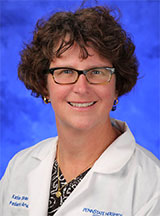
Dr. Katie Donahue
The goal of the International Experience is to support outstanding anesthesiology residents with interest in outreach and medical mission services.
A cherished friend and mentor to the department, Dr. Katie Donahue, graciously supported the departmental passion for giving back to the world with the Dr. Katie Donahue Resident International Anesthesia Endowment, which is also supported by alumni and friends.
This endowment funds the resident’s participation in designated travel opportunities such as those outlined here. The goal of these experiences is to provide acute care for the patients as well as create long-term relationships, and assist in developing solutions for education, research and clinical care with local people. More opportunities are also available for discussion.
To Apply
Residents interested in the Dr. Katie Donahue Resident International Anesthesia Endowment must submit an application including the following items:
- Statement of career goals
- Updated curriculum vitae
The International Experience Selection Committee, led by International Experience Director Shanno Grap, MD, will review all applications and interview selected residents.
Eligibility
The competitive international opportunities will be awarded to residents for travel in their PGY-4 year or the latter portion of their PGY-3 year based on the following:
- Outreach interest
- Clinical performance, including competence and satisfactory progression as judged by the Clinical Competency Committee
- Academic performance, including passing ABA Basic Examination and in-service training exam scores greater than the 50th percentile
- Completion of pediatric anesthesia rotation
International experience options are listed below.
When: Fall or Spring
Type: Medical mission
Where: Recent sites have included Vietnam and China
Details: This is a 12-day clinical opportunity for a PGY-4 resident or pediatric anesthesia fellow to provide anesthesia for children with cleft lips and palates under supervision by one of the Penn State Health Department of Anesthesiology and Perioperative Medicine faculty members.
Anesthetic environment: Teams of in-country, regional and international credentialed volunteers work together with interpreters. Equipment includes local and imported supplies that meet their Global Standards of Care, state-of-the art sophisticated equipment. Practices, equipment and anesthesia are standardized, regardless of geographical location. Operating rooms are equipped with the most up-to-date supplies.
When: September, January and/or March
Type: International anesthesia rotation
Where: Ethiopia
Details: These are three separate one-month rotations for a PGY-4 resident (or PGY-3 eligible for Call Chief) at the CURE Hospital in Addis Ababa, Ethiopia, under direct supervision of the American Anesthesia Program Director. This includes clinical care of pediatric orthopedic patients in the operating room, active involvement in the ongoing outcomes research project investigating postoperative mortality and teaching of Ethiopian master’s students.
Anesthetic environment: This is a state-of-the-art 35-bed hospital established in 2008 using modern equipment and monitoring of the caliber with which trainees are familiar at Penn State Health.
When: Spring
Type: Medical mission
Where: Dominican Republic
Details: This is a one-week clinical opportunity for a PGY-4 resident to provide anesthesia for children and adults for ophthalmologic cases under supervision by one of the Penn State Health Department of Anesthesiology and Perioperative Medicine faculty members.
Anesthetic environment: This is an austere environment in a public hospital with severe shortages. Residents will use old, unfamiliar anesthesia machines as well as a portable Glostavent. Agents include sevoflurane, halothane and nalbuphine. Cases are outpatient, healthy track, ASA 1-2. All general anesthetics require LMA and spontaneous breathing in light of a sparsely equipped ICU for backup.
Resident Honors and Recognitions
Penn State College of Medicine and Penn State Health Milton S. Hershey Medical Center accept ongoing nominations for the Exceptional Moments in Teaching award.
The award, given monthly by the Office for a Respectful Learning Environment, accepts nominations from College of Medicine students who are invited to submit narratives about faculty members, residents, fellows, nurses or any other educators who challenge them and provide an exceptional learning experience. See more about the award here.
Previous nominees from the Anesthesiology Residency are listed here. Click the + next to a nominee name to read their nominator’s comments.
The annual Resident/Fellow Research Day is held each year (with exception of during the COVID-19 pandemic) on and around the Penn State Health Milton S. Hershey Medical Center campus.
The intent of the event is to provide an opportunity for residents and fellows to showcase their research accomplishments to their peers in other clinical departments, as well as their colleagues in the basic sciences.
Learn more about Resident/Fellow Research Day here.
Previous presentations from the Anesthesiology Residency are listed here.
Each year, trainees in the Anesthesiology Residency present the Kim L. Walker Faculty Teaching Award to recognize outstanding faculty achievement in didactic and/or clinical teaching of residents in the Department of Anesthesiology and Perioperative Medicine during the past academic year, as well as for excellence in serving as a mentor, guiding residents in the development of their careers in anesthesiology at Penn State College of Medicine.
From 2007 to 2018, the residents also presented a Senior Faculty Teaching Award to associate professors and professors and the Junior Faculty Teaching Award to clinical instructors and assistant professors; since that time, the program has transitioned to honoring the first-, second- and third-place faculty nominated for the Kim L. Walker Faculty Teaching Award, regardless of title or rank.
The first-place faculty member is named the Kim L. Walker Faculty Teaching Award recipient, and the second- and third-place faculty members receive the Faculty Teaching Award.
Latest News from Anesthesiology



